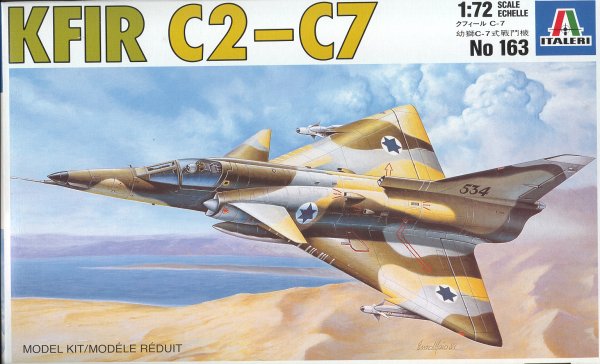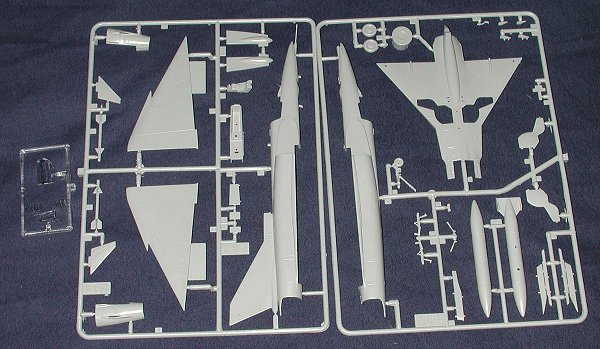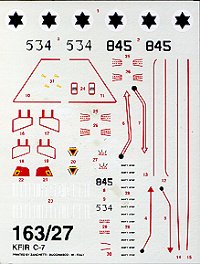
|
KIT: |
Italeri 1/72 Kfir C.2 / C.7 |
|
KIT # |
163 |
|
PRICE: |
$9.99 |
|
DECALS: |
Two Aircraft |
|
REVIEW & |
|
|
NOTES: |
Kit vacuform with white metal |

|
HISTORY |
Back in the early 1960s, Israel's air force was dependent on France for much of its modern military hardware. One aircraft that it was very impressed with was the Mirage 5. This aircraft was basically a ground attack plane, but was able to carry air to air missiles in case things got a bit hot. The Israeli's liked the Mirage IIIC that it was using and it proved to be a potent, if short legged aircraft in the 1967 and 1973 wars against Egypt.
But I'm getting a bit ahead of myself. Thanks to the '67 war and the usual pressures put on countries, France embargoed the Mirage 5 aircraft it had built for Israel. These aircraft were finally incorporated into the French Air Force where they performed well for decades while the Israeli's got their money back. Israel still needed planes, so they 'obtained' the plans for the Mirage 5 and went about to build their own. There was also a problem with engines as they were also unavailable. However, the US had become Israel's supplier of choice and part of that were J-79 engines for the Phantom.
The J-79 is a powerful, and a bit smoky engine that looked perfect for the Israeli-built Mirage (now called Kfir). Mating the engine with the Mirage airframe produced a very fast and capable aircraft. Still designed as a ground attack plane, the Kfir was able to hold its own in air to air combat. The small canards attached to the intakes improved overall maneuverability and were applied to a number of Mirages in other countries as well. The need for more air for the more powerful engine resulted in additional air scoops at the fin base and the upper fuselage.
The Kfir C.2 was leased for three years by the USN/USMC as the F-21A for DACT and flew with VF-43 and VMFAT-401. Other Kfirs were sold abroad, most notably to Ecuador who has a number of Mirage variants. It is also the basis for the South African Cheetah. Though those planes were developed locally, they are somewhat based on data from the Kfir.
|
THE KIT |

For those of you who have built the Italeri or Testors 1/72 F-21A kit, you will see that this is basically the same kit. The biggest difference is that the canards are larger.
One thing that is noticeable is that the thicker parts of the kit (basically the upper wing halves) suffer somewhat from sink marks. These will not be that pleasant to fill. The most noticeable are on the elevons and near where the wing joins the fuselage and on the leading edges. A few more sink marks are on the fuselage where the alignment pins are located. Another thing is that the fin inlet seems to be a bit on the thin side and is not open.
The cockpit tub is built into the nose wheel well assembly. It is a bit basic,
but adequate for 1/72. A bang seat is also provided, though replacing it would
be a good idea if you can. There is no console detail but the instrument panel
has nice raised detail on it.  Options
are an open or closed canopy and underside stores. You get a single centerline
drop tank and two wing mounted Sidewinders, though I guess they are the Israeli
equivalent. These are pretty plain as well and could stand to be replaced.
Options
are an open or closed canopy and underside stores. You get a single centerline
drop tank and two wing mounted Sidewinders, though I guess they are the Israeli
equivalent. These are pretty plain as well and could stand to be replaced.
Landing gear are well done and the nose wheel is molded in with the nose gear strut, an accepted practice in this scale. Gear doors are molded closed and need to be cut apart if modeling it with gear down. Canards are only the large ones. I had thought that the C.2 had the smaller ones as on the F-21A. Perhaps a reader can enlighten me on this.
Instructions are more than adequate and include a photo of the completed kit and a real Kfir. Decals are for two Kfirs and the color and painting diagram is on the back of the box. One is in the four color desert scheme and the other is in the two color grey scheme. A goodly number of stencil markings are supplied. The decals themselves are very glossy and well printed. It almost looks as if they have a sheet-wide carrier film, but I would think that not to be the case.
|
CONCLUSIONS |
Overall, it looks like a very nice model. When one considers that the Hasegawa variant is around 20 years old, this 1995 mold is a definite improvement. Now to see how well it builds!
Review kit courtesy of my kit collection.
If you would like your product reviewed fairly and fairly quickly by a site that has over 100,000 visitors a month, please contact me or see other details in the Note to Contributors.